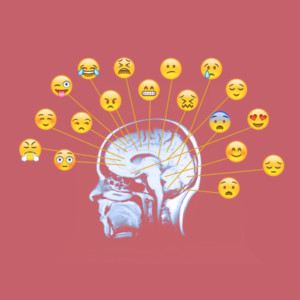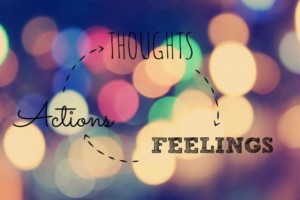What do you do when you need to quickly clarify what you are feeling, or what your emotions are?
Your friend asks “How are you feeling?.” Your wife asks “How are you feeling about us?” Your counselor asks “How are you feeling about your life?” What happens when you just want to check in with yourself, to get some clarity and do a “gut check”?
In this post, I want to give you a useful tool for identifying and expressing your emotions. I use this tool quite often myself, and with my clients, and am sure you will find it helpful in many areas of your life.
The tool I will share is my version of a “feelings vocabulary list” that I use to help clients better articulate their emotions. You’ll find many versions of these lists online. My list includes a large sample of feelings words (e.g., anxious or confident), examples of bodily sensations (e.g., breathless or cozy), and a list of behaviors or actions that tend to flow from emotional states. For example, when we feel lethargic, we might “veg out” or when we feel empowered we are more likely “speak up” for ourselves.
The Two Ways to Use a Feelings List
There are two broad ways to use a feelings vocabulary list. You can use it retrospectively to describe emotions you are feeling now or have felt in the past (even long ago), to get clear on these feelings and to put them into words. You can also use a feelings vocabulary list in a proactive, future-focused way to identify the feelings you would like to have, and to foster or grow in your life.
Everyone has Emotions
All sentient beings, certainly humans and other animals, and even more simple creatures like plants or bacteria have reactions to go toward things in their environment that are enticing and to pull away from things that are threatening (so-called “approach” or “avoidance” reactions in the language of psychology). This is the primal basis of our emotions. In fact, Charles Darwin published a very interesting book on “The Expression of The Emotions in Man and Animals” in the 1870’s, one of the first books illustrated with photographs, to explore the universal nature of emotions.
The idea that some people are emotionless is not true. It’s impossible to live and not to have emotions. Simply expressing a feeling out loud has measurable physical effects on your brain and body. But, we might truly say that someone “has no feelings” if their emotional vocabulary is especially sparse. There is even a word for the personality trait of having no language for feelings: “alexithymia.” In fact, researchers even have a label for the common problem of men being cut off from their feelings: “normative male alexithymia.” In my experience, anyone can be coached to better describe their feelings and emotions (even men!). Giving people a written list of feelings, bodily sensations and behaviors is often a useful starting point for putting words to your emotions.

The Difference between Emotions & Feelings
It’s helpful to understand the difference between feelings and emotions. Emotions like anger or joy are mind-body states that arise in response to something in the environment. As I noted, all living beings have emotions. We can measure these in various ways such as heart rate or skin temperature. Feelings, on the other hand, are the words—the language— that we use to describe our emotions. The ability to express feelings varies widely among people, based on factors such as our age, maturity, education, and what we have learned about feelings from our families and our culture.
Having an Expanded Feelings Vocabulary Directly Builds Emotional Intelligence
As we add words to our feelings vocabulary, we become more intelligent about our emotions.
Emotional intelligence (EI) is simply understanding and insight about our own emotions and an ability to express them. EI also entails the ability to understand other people’s emotions and to name and validate those. Using a feelings list is a concrete way to develop this emotional intelligence.
For example, the emotion of anger can take many forms from mild irritation to blind rage. The more detailed you can be about what kind of anger you feel, what caused it, and what you want to do about it, the more insight you can have into your specific emotional state. And with insight comes the ability to take actions that make things better. This is “emotional intelligence” in practice. This ability in turn helps us to better detect other peoples’ feelings and to empathize with them.
Getting the Feeling Word Just Right
By using the right feeling word we can be quite precise, nuanced and expressive about our emotions. A metaphor I use with clients is that of a water color painting set: You can have a cheap set of a few basic colors (black, red, green, yellow, blue, etc.) or you can have an expensive set of 50 or 100 colors (e.g., with several shades of blue: sky blue, aquamarine, navy, teal, cerulean, etc.). I want you to think of yourself as an artist or poet who has a wide feelings vocabulary at their creative disposal.
For example, if you experience anger, there are important differences between feeling irritated over the long line at the coffee shop, feeling betrayed by a friend, or feeling hurt or protective because of your spouse’s disparaging remarks about one of your family members. Stress or fatigue could range from a pleasant sense of being worn out after a good day of work to an unhealthy sense of feeling dangerously depleted or burned out. Your positive feelings in the presence of a loved one could range from being calm or warm, to feeling satisfied or passionate, to feeling ecstatic or blissful.
Growing your Emotions
The funny thing is, the larger your feelings vocabulary is, the wider the range of emotions you can express. And the wider the range of emotions you can potentially express, the richer and fuller your life will be. You can literally grow your ability to have emotions that were previously unavailable to you because you did not have a word to express them.
For example, last winter when the days were dark and short, I reviewed the list and was struck by the word “invigorated.” Shortly after, I went with my daughter to cut down a Christmas tree and bring it home. As we drove home with the fresh-cut tree in our small car, the evergreen scent was so good and strong, and I realized that I felt “invigorated” by the smell. By scanning the list, I had created a space in my mind to feel something good, even in the dark days of winter.
Actions and Feelings

What is unique about my list is that I also include a sample of behaviors and actions. It’s clear that there is a relationship between our feelings, the sensations we are feeling in our body, and our actions. I find that people who are not sure about what they’re feeling can work backward from their actions
For example, if are feeling “curious,” we might have a sensation of being “active” in our body and this may lead us into “researching or looking-up” kind of behaviors. If we’re feeling “calm” and “patient,” our body sensation might be “relaxed” or “alert,” and this might lead us to be more observant and a better listener.
Conversely, if were feeling “down” or “lonely” or “sad,” it’s likely that we will have sensations of low energy or pain in our bodies that lead us to behaviors such as isolating, “vegging out,” being restless and pacing, or even getting angry and hitting things.
Conclusion
Using a feelings list gives insights into your current emotional state, and is also a powerful tool for imagining how you’d like to feel. You will have a robust set of options for expressing the nuances of your feelings and can directly apply this in your life and your relationships. Over the years, I have used this tool with many clients. In addition to revealing your own emotional states, using a list also builds your emotional intelligence about others. Whether you become a better listener with your spouse or a more astute colleague at work, understanding the emotions of other people can be a crucial foundation of our own happiness.
Have a look at this list and see what resonates with you. And feel free to give me a shout if you’d like to work on expanding your own feelings vocabulary as a springboard to a richer, more satisfying life.

